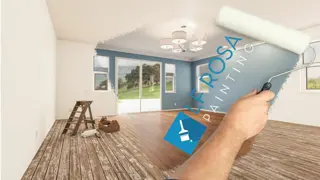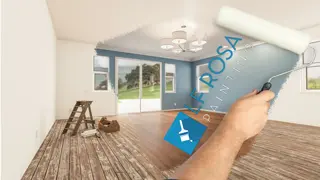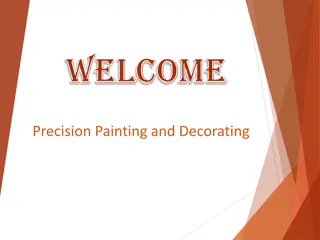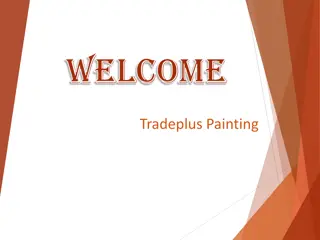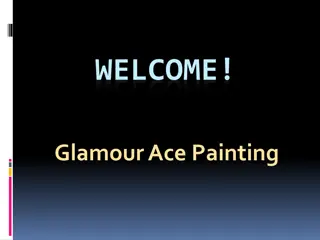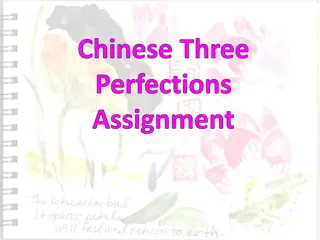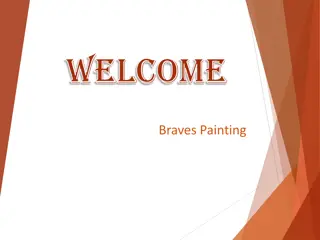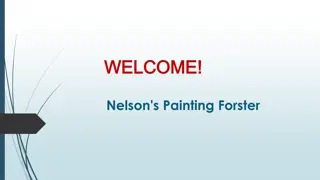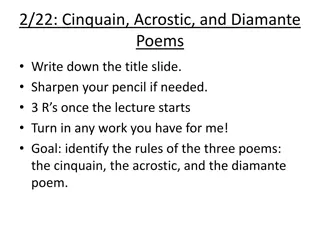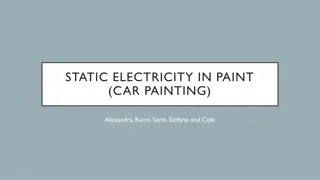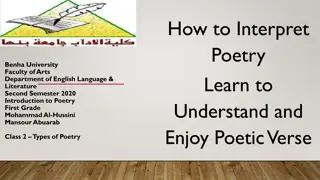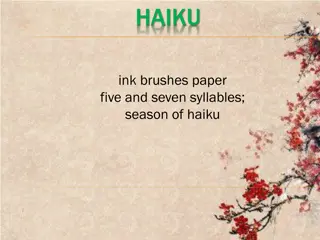Exploring the Art of Poetry and Painting: Haiku, Cinquain, and Creative Interpretations
Dive into the world of poetry and art through the ancient Japanese tradition of Haiku and the modern form of Cinquain. Learn how to respond to paintings with vivid imagery, textures, and emotions to create evocative poetry. Unleash your creativity as you craft captivating verses inspired by visual masterpieces, blending words and colors into a harmonious symphony of expression.
Download Presentation

Please find below an Image/Link to download the presentation.
The content on the website is provided AS IS for your information and personal use only. It may not be sold, licensed, or shared on other websites without obtaining consent from the author. Download presentation by click this link. If you encounter any issues during the download, it is possible that the publisher has removed the file from their server.
E N D
Presentation Transcript
Writing about the Arts: Poetry Critique How-to Article Traditions Essay Judy Sizemore Kentucky Arts Council
Responding to the Arts through Poetry Haiku Haiku is a Japanese tradition of poetry that uses strong sensory and emotive images in an unrhymed, metered pattern: Line 1 5 syllables Line 2 7 syllables Line 3 5 syllables
Create a Word Bank To write a haiku, it helps to begin by creating a word bank. Write down words and phrases that answer the following questions and use your answers to make lines with the proper number of syllables. Use specific language. In other words, don t just say a tree. Call it a maple, oak, birch, pine, flowering dogwood, or some other kind of tree.
Jot down answers to these questions: What is the focal point of the painting? What draws your eye? Describe the colors you see in the painting. What object is that color? (such as dazzling red sunset, faded orange hair, soft blue sweater, bright chartreuse caterpillar) Describe the textures of objects in the painting. What object is that texture? (such as soft petals, wet leaves, scratchy branches, smooth water )
Describe the perspective of the painting (such as looking up to something towering above you, looking across a wide space, staring something in the eye, a bird s eye view) What does the painting remind you of? (Use a metaphor or simile) How does the painting make you feel? (Avoid words like good or nice. )
Haiku Example Forest snow The Master s fine brush Painting delicate white lines On silent branches.
Cinquain Cinquain is a form of poetry with five lines (from the French word cinq, meaning five). A cinquain is often just one stanza. It uses poetic devices. Not rhyme and rhythm, but alliteration and simile.
Example Summer Pond Dragonflies Transparent blue Glittering, gleaming, glowing, Like ghost visitors from another world, Magic.
Alliteration Activities Alliteration means using words that start with the same sound. How many words can you find that start with the same sound in this poem? Take a moment to think of some phrases that use alliteration. Two adjectives (describing words) that start with t and could be used to describe a tree. Two adjectives (describing words) that start with s and end with ing and could be used to describe the motion of a snake. A noun and two adjectives that describe the noun. All three words must start with the same letter.
Simile Activities Simile means to compare one thing to another thing that is quite different, using like or as or than for the comparison. Take a moment to make up some similes. The wind sounded like The clouds looked as as That girl is sweeter than
Diamante Poetry Diamante poems are written to form the shape of a diamond. They create a strong contrast between two themes (warm or cool colors; wet or dry texture; straight or wavy lines; positive or negative space; geometric or organic shapes). They have seven lines and a title.
Line One one word (your first theme) Line Two two words describing or relating to the first theme Line Three - three adjectives that end in ing and describe the first theme. Line Four Two words related to the first theme: Two words related to the second theme. Line Five - three adjectives that end in ing and describe the second theme Line Six - two words describing the first theme Line Seven a noun (your second theme)
Writing a Diamante The easiest way to write a diamante is to begin with lines one and seven your terms of contrast. Then you can write to the middle, completing lines 2 and 6, 3 and 5 and then line 4, where the division between themes takes place. Some students find it easier to write lines one and seven and then go in order 2, 3, 4 (with the change over), 5 and 6. Be sure to model the process!
Example Values Tints Pale, soft, Whitening, fading, vanishing, Dawn, light : shadow, dusk Blackening, dimming, disappearing Dark, strong, Shades
Free Verse Example A Poem Is Words and phrases, not sentences, Broken into lines that make you stop and think, Sights, scents, and sounds captured with a net of words.
Just like the name says, this type of poem is free to take any shape the poet wants. But does it have characteristics that make it a poem? It has line breaks and poetic devices. Line breaks often make use of white space, or empty spaces in the line or between lines. Usually this is done to draw attention to certain words or ideas. How is white space used in this poem? What words does the white space call attention to? Can you find the alliteration in this poem? That is one poetic device. The other is figurative language. A net cannot really be made of words, and you could not really catch sights, scents, or sounds in a net like butterflies.
Similes and Metaphors This type of figurative language, when you compare a poem to a net but do not use like or as is called a metaphor. What s the difference between a simile and a metaphor? Simile: The sun is like a golden ball in the sky. Metaphor: The sun is a golden ball in the sky. Simile: Her hair is as soft as silk. Metaphor: Her silken hair was long and black.
ELA Common Core Standards for Informational Writing Write informative/explanatory texts to examine a topic and convey ideas, concepts, and information through the selection, organization, and analysis of relevant content. a. Introduce a topic clearly, previewing what is to follow; organize ideas, concepts, and information into broader categories; include formatting (e.g., headings), graphics (e.g., charts, tables), and multimedia when useful to aiding comprehension.
ELA Common Core Standards for Informational Writing b. Develop the topic with relevant, well-chosen facts, definitions, concrete details, quotations, or other information and examples. c. Use appropriate and varied transitions to create cohesion and clarify the relationships among ideas and concepts.
ELA Common Core Standards for Informational Writing d. Use precise language and domain-specific vocabulary to inform about or explain the topic. e. Establish and maintain a formal style. f. Provide a concluding statement or section that follows from and supports the information or explanation presented.
Critiquing a Work of Art There are four steps to writing a critique: 1. Description 2. Analysis 3. Interpretation 4. Evaluation Emphasize that in writing their critique of their own artwork, students should use the art terminology they have learned.
Describe Describe the type of artwork, including medium and technique Describe the size and subject matter. Describe how the elements of art are incorporated into the artwork (the color scheme, the types of lines, the form, and the texture.
Analyze How have the elements of art been used to create: Balance Contrast Emphasis Contrast Unity
Interpretation and Evaluation What is the purpose of this artwork? Does it have a meaning for you? Is the artwork successful in using the elements of art and principles of design to represent the subject? Is it successful in communicating your ideas or feelings?
How-to Lead the students in writing a how-to feature article about their art experience. Illustrate it with step-by-step photos of the process. Introduction: Opening paragraph introduces the topic with a quick summary of the project, including who, what, when, where, and why. Background information tells about connections to art, culture, concepts, or other ideas. (In this case, the environment is a good connection to include.)
Body of the Article - Process: Begin the explanation of the how-to process with a description of the tools and material. Explain each step in the process. Conclusion: Describe how you felt about this project.
Extension: Informational Writing Writing about a Tradition Many people in sing or play traditional music. There are many other traditions in the community. Write an essay about a tradition that is important to your family, your school, your church, or your community.
Possible Topic Ideas Family trips, gatherings, or reunions Holidays or traditional family celebrations Arts and crafts Music Gardening or farming Cooking or special meals Sports Fishing or hunting Four-wheeling or horse back riding
Research For this essay, you need to do a different type of research. Instead of looking on the Internet or in a book, you need to interview people in your family, school, church, or community to get more information about how long the tradition has been passed on and other important information. It is a good idea to make a list of questions to ask and to take notes on the answers.
Introductory Paragraph When you have researched the tradition, you are ready to begin. Briefly describe the tradition and why it is important to you, your family, your church, or your community.
Body of the Essay Explain the who, what, when, where, and how of the tradition. Think about these questions: Who is involved in this tradition? Who taught you about it? What do you do? When do you do it? Where do you do it?
Add some details on how the tradition is carried out. You might give some how-to information, such as how to bait a hook, how to grow tomatoes, how to set up a tent, how to knit a scarf, how to play basketball, etc.
Conclusion In the conclusion, return to talking about why the tradition is important. Explain why it matters to you. Will you pass it on to your children in the future? Why?


